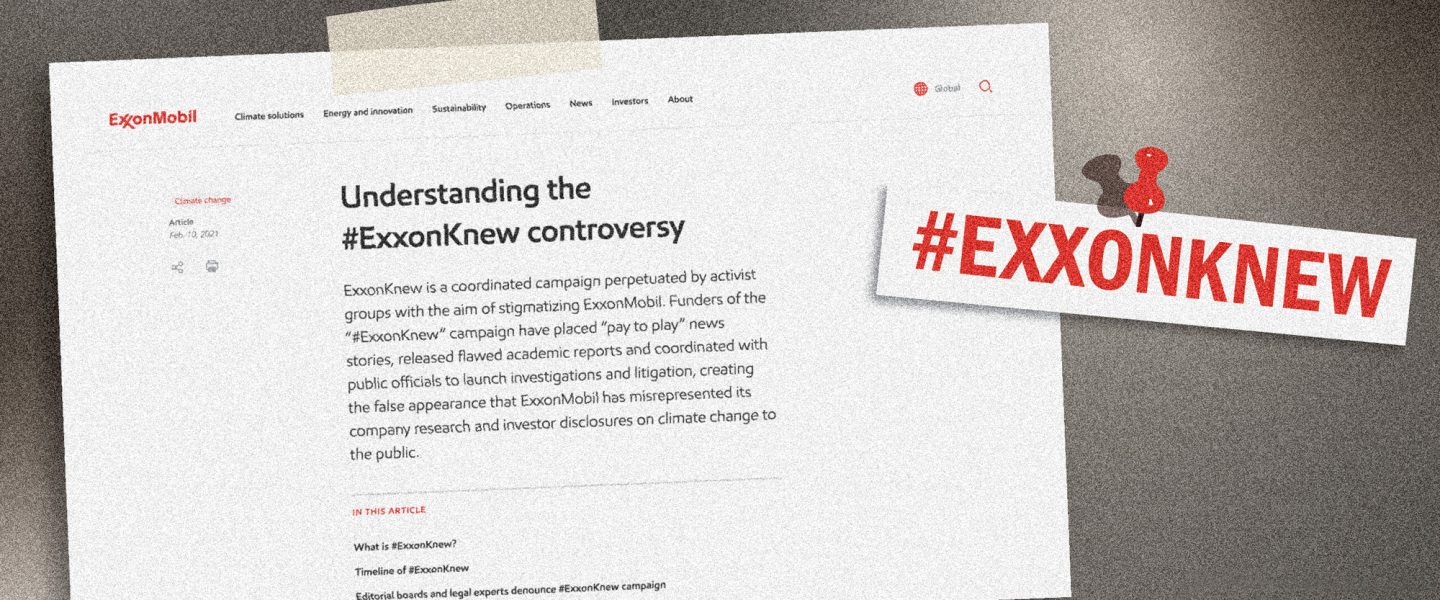Why Did Exxon Take Down a Webpage Attacking Its Critics?
Exxon’s official corporate rebuttal to #ExxonKnew has mysteriously disappeared after seven years.
|
Listen To This Story
|
This story by Emily Sanders was originally published by ExxonKnews (a project of the Center for Climate Integrity) and is part of Covering Climate Now, a global journalism collaboration strengthening coverage of the climate story.
•
A page on ExxonMobil’s website that sought to refute calls for the oil giant to be held accountable for its climate deception appears to have been taken off the internet after seven years.
The webpage, an official corporate rebuttal to the #ExxonKnew movement, accused Exxon’s critics of plotting together to “delegitimize ExxonMobil by misrepresenting our position on climate change and related research to the public.” Starting in 2018, just after the first climate accountability lawsuits were filed, a montage-style video flooded Twitter feeds to promote the “real story behind #ExxonKnew” and drive traffic to the now-defunct webpage. According to Exxon, it was activists and community leaders, not the fossil fuel industry, who were telling lies.
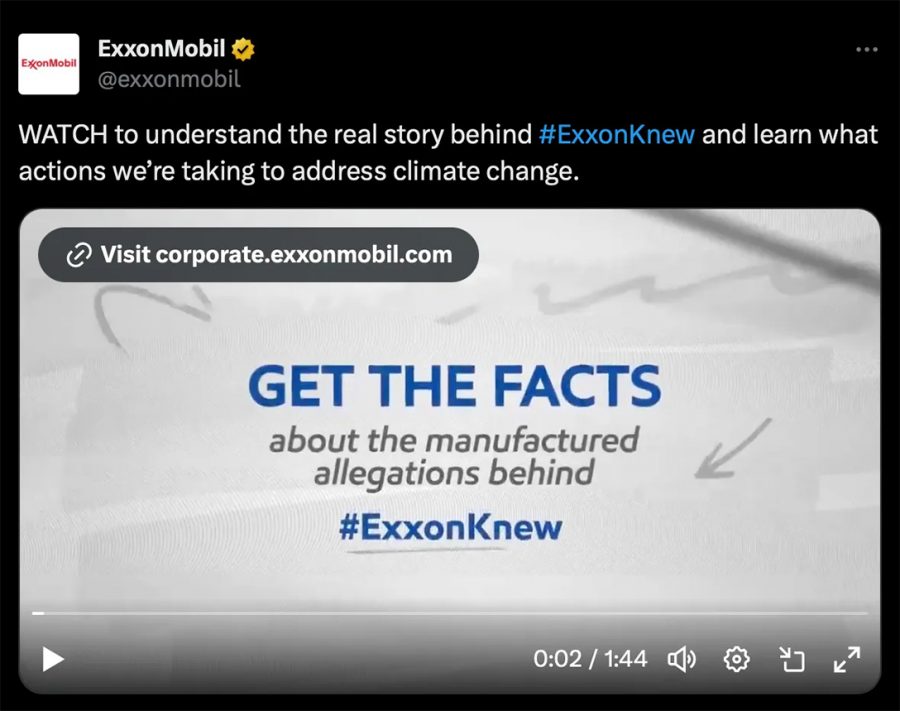
The “Understanding the #ExxonKnew Controversy” page on Exxon’s website became home to an all-out strategic communications blitz against activists, lawyers, and others fighting to hold Exxon accountable. The page intended to cast doubt on the growing evidence that Exxon knew for decades that its products caused climate change but then led a massive campaign of deception to protect its profits. Its allegations — that advocates, elected officials, and plaintiffs in climate lawsuits had engaged in a so-called “coordinated campaign” against the oil giant — have been repeated in courtrooms across the country by Exxon’s lawyers.
One of the critics Exxon named on the webpage was Naomi Oreskes, a professor of the history of science at Harvard University and scholar of climate disinformation. Oreskes has published prolific research exposing Exxon’s early knowledge and subsequent campaigns to create public uncertainty about climate science.
“ExxonMobil has long tried to distract attention from their long, well-documented history of denying or minimizing the risks of climate disruption caused by the intended use of their products,” Oreskes told ExxonKnews in an email. “When people — academics, journalists, even their own former employees — discuss what they have done, they attack the messenger. As we’ve said before, they misrepresent their own history of misrepresentation. We have shown this to be the case. The tiger has not changed its stripes.”
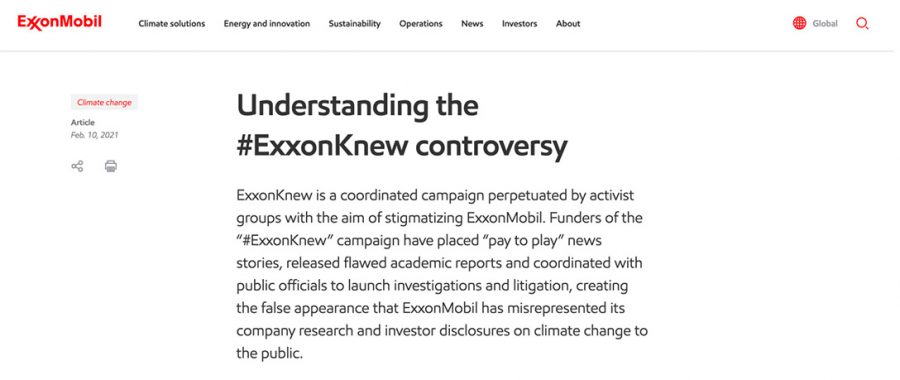
In April, seemingly out of nowhere, the page disappeared.
So Why Did Exxon Take Down Its Rebuttal After All This Time?
Exxon faces a clear and rising threat of “massive monetary liability” and is deep in the throes of a damaging public reckoning. Last month, The Wall Street Journal published more documentation of the oil giant’s attempts to undermine climate science well into the 2010s. The attorney general of California sued the company in a landmark case that opened the floodgates for more states to take legal action. Most recently, Exxon suffered its seventh painful defeat in a federal appeals court. A judge who ruled in Exxon’s favor in an earlier New York case — a ruling the company’s lawyers are still citing as evidence that Exxon shouldn’t face trial in state courts — agreed, along with two of his colleagues, that Connecticut’s climate fraud lawsuit against Exxon should indeed proceed in state court. Across the country, climate accountability lawsuits against Exxon are now advancing toward trial, where the company will be up against a mountain of proof that it knowingly endangered the planet.
In erasing the webpage, Exxon could simply be dropping its public defense or signaling a change in strategy — but some notable markers at the start and end of this website’s tenure raise more questions.
Here’s a brief timeline of events:
- September – December 2015: Revelations that sparked the #ExxonKnew movement are published by Inside Climate News and the Los Angeles Times.
- March 2016: Energy in Depth (EID), a pro-fossil fuel “news” site that was created in part thanks to Exxon’s financial contributions and has reportedly taken content direction from Exxon, releases a video remarkably similar to the one Exxon would later publish, calling the #ExxonKnew reporting a “deliberate misrepresentation of the facts.” EID is staffed by employees of the strategic communications division of FTI Consulting, a firm that ran covert influence campaigns to promote fossil fuels for major client Exxon, according to reporting from The New York Times.
- August 2016: The first trace of Exxon’s webpage on the internet’s archive. Built to look like a news article, the page calls journalistic reports on what Exxon knew “bought and paid for” and features a lengthy timeline of supposed evidence of the “coordinated campaign” against the company.
- March 2023: The Wall Street Journal publishes an exclusive report on a hacking-for-hire operation that targeted prominent climate activists campaigning against Exxon. Federal prosecutors have not yet identified a source behind the attack beyond an Israeli private detective who was an intermediary, apparently connecting clients with Indian hackers for hire. That person will be sentenced in New York City, according to an email from the US Department of Justice sent to victims of the hacking scheme.
The Journal’s article specifically highlights one particular focus of the Manhattan US attorney’s office investigation: a spear-phishing campaign targeting the recipients of a private email about a meeting in January 2016 where a communications plan to expose Exxon’s deception was discussed. A copy of that private communication was somehow obtained by The Wall Street Journal and Washington Free Beacon, and published in the Washington Free Beacon in April 2016.
As mentioned in The Journal’s reporting, that hacked email was cited in the timeline on Exxon’s #ExxonKnew rebuttal website, as well as in court briefings and statements by Exxon’s lawyers, who used it to argue that advocates were plotting to push prosecutors into unfairly investigating the company as part of a “vilification agenda.”
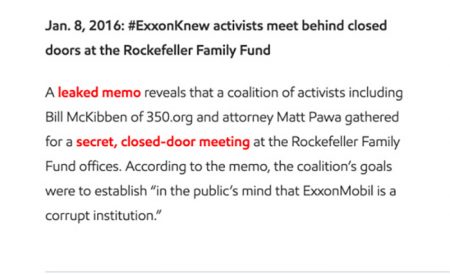
- April 2023: Exxon takes its webpage down.
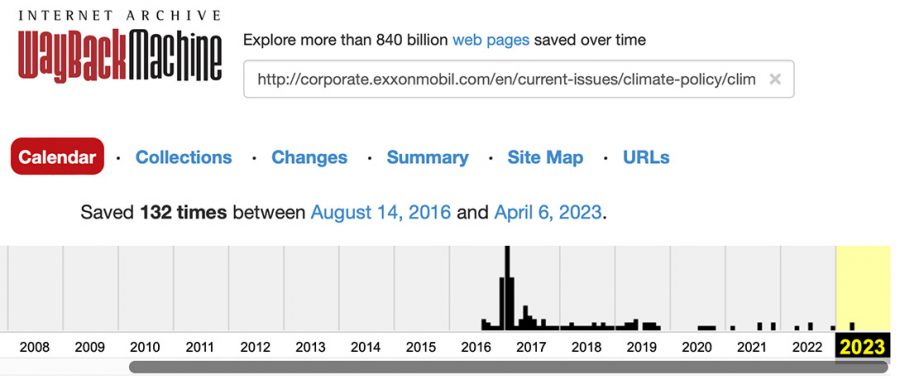
ExxonKnews has asked Exxon why the webpage was taken down, and if the publication of The Wall Street Journal story in March was a factor. ExxonKnews will update this story if a response is received.
